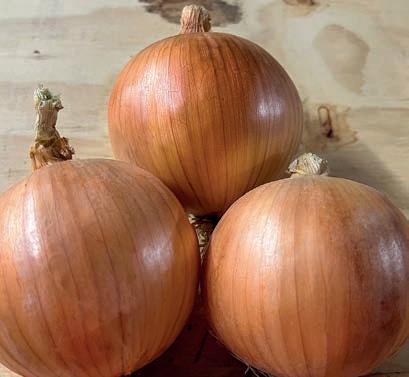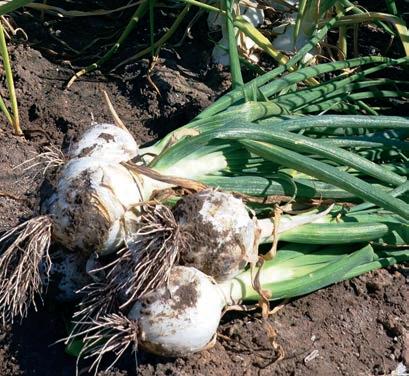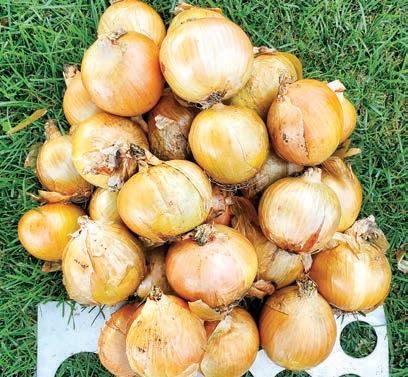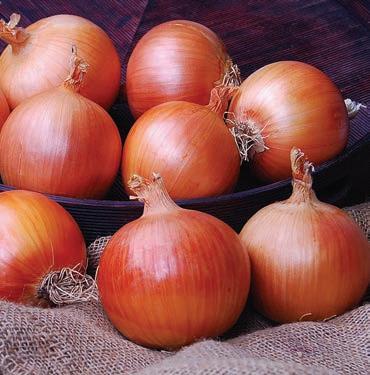




























seed treatments provide early season disease and insect protection for young onion crops. Seed Dynamics applies the protectant to the seeds themselves, through a safe and controlled delivery. It works at the most critical time — during germination and seedling emergence — so your seeds can thrive, while fending o threats of early damage. Get a hero from Seed Dynamics , the Seed Preparation Professionals. Call us at 86 6.321.9747 or choose a dealer listed above. Visit our Website at SeedDynamics.com! When onion seed and seedcorn maggots threaten young crops, our heroes come prepared. FarMore FI500 and Spinosad/Lumiverd
















Mechanical
PO Box 333 Roberts, Idaho 83444
Telephone: (208) 520-6461
Circulation: (503) 724-3581
OnionWorld.net
Editor Denise Keller editor@ColumbiaMediaGroup.com
Publisher / Advertising Manager
Dave Alexander dave@ColumbiaMediaGroup.com
Director of Operations
Brian Feist brian@ColumbiaMediaGroup.com
Onion World is interested in newsworthy material related to onion production and marketing. Contributions from all segments of the industry are welcome. Submit news releases, new product submissions, stories and photos via email to: editor@ColumbiaMediaGroup.com, or call (509) 697-9436.
For information on rates, mechanics, deadlines, list rental, direct mail, inserts or other information, call (208) 520-6461 or email: dave@onionworld.net
U.S. $24 per year
Canada $40 per year Foreign $80 per year
Subscribe online at: www.OnionWorld.net/subscribe or call (503) 724-3581.
Email address changes/corrections to brian@ColumbiaMediaGroup.com or mail to: Onion World PO Box 333 Roberts, ID 83444
Onion World magazine (ISSN 0892-578X), is published eight times a year and mailed under a standard rate mailing permit at Idaho Falls, Idaho and at additional mailing offices. Produced by Columbia Media Group PO Box 333, Roberts, ID, 83444. Copyright 2024. All rights reserved.
No part of this publication may be reproduced or transmitted in any form or by any means, electronic or mechanical, for any purpose without the express written permission of Columbia Media Group. For information on reprints call (208) 520-6461.








By Leonardo “Leo” Salgado and Brian Nault, Department of Entomology, Cornell AgriTech, Cornell University; and Rob Wilson, Division of Agriculture and Natural Resources, Intermountain Research and Extension Center, University of California


Onion
maggot and seedcorn maggot are major pests of onion and, if not controlled, can reduce plant stand up to 75 percent (Fig. 1). Since chlorpyrifos was banned a few years ago, insecticide seed treatments have become relied upon as the sole option for protecting onion seedlings from maggots. Seed treatments serve as a preventative approach for maggot control because once onions are infested, there is no way to rescue them (Fig. 2). Some insecticide seed treatments may be more effective against one maggot species than the other. Therefore, choosing effective insecticide seed treatments for one or both maggot pests is critical for protecting the onion crop.
This article provides an update on current and future options for managing maggots with insecticide seed treatments. Additionally, we comment on our experience evaluating one or more insecticide active ingredients in the seed treatment package. The focus is on
maggot management in New York’s muck cropping systems where onion maggot abundance is higher than seedcorn maggot. However, we also discuss how these combinations have performed in a northern California onion production system where seedcorn maggot is dominant.
Lumiverd is a formulation of the active ingredient spinosad, which has been highly effective in controlling onion maggot and seedcorn maggot. In the past, this active ingredient was included in Syngenta’s FarMore FI500 package as Regard SC. In late fall 2022, Corteva (spinosad’s manufacturer) registered Lumiverd on onion. Currently, Lumiverd is the only spinosad seed treatment available for onions.
For over a decade, spinosad has been one of the most effective insecticides for controlling both maggot species. However, in recent years in central
New York, we have noticed a decline in spinosad’s performance in our onfarm insecticide seed treatment trials. On one farm, we attribute the reduced performance to insecticide resistance.
Trigard is a formulation of the active ingredient cyromazine, which has been available commercially for several decades. Unlike Lumiverd, Trigard is only effective against onion maggot. Since Syngenta no longer has Regard SC, the “new” FarMore FI500 package has replaced Regard with Trigard.
In our New York field trials, Trigard often performs very well by itself, likely because onion maggot is typically the dominant pest. In contrast, Trigard has performed poorly in regions in the western U.S. where seedcorn maggot is most common. This year in our New York field trials, Trigard did not perform as well as in the past. We suspect that the reduced performance was caused by


an early outbreak of seedcorn maggot, which was particularly troublesome for many crops in New York this spring. As expected in trials in California this year, Trigard alone performed very poorly.
Cruiser is a neonicotinoid insecticide that contains thiamethoxam. Cruiser is included in the FarMore FI500 package and has been commonly used on onion for well over a decade. Despite being highly effective for protecting beans, peas, corn and cucurbit crops from seedcorn maggot, Cruiser is not very effective against either maggot species in onion.
Sepresto is another neonicotinoid seed treatment, and it contains a 3:1 blend of clothianidin and imidacloprid. Sepresto initially was only available for use on Nunhems’ onion varieties, but it is now available for use on all onion varieties. Sepresto has not been used very often as a seed treatment option for onion growers in New York. This is likely because FarMore FI500 has been very effective and results from our past


studies in New York have not shown Sepresto to be very effective. However, for the second year in a row, our research results in New York have identified Sepresto as the best-performing insecticide seed treatment for maggot control. In previous research trials in New York between 2008 and 2017, Sepresto averaged only 58 percent control of maggots (range in control was 30–91 percent). In California, Sepresto has performed well and is commonly used.
Plinazolin technology contains the active ingredient isocycloseram, which belongs to a new class of chemistry called isoxazolines. Plinazolin technology is not commercially available as a seed treatment, but Syngenta is hopeful that it will become registered as a seed treatment on onion for maggot control in a few years. Based on our experience with Plinazolin technology over the past couple of years, it has performed better in California than in New York.
In recent years in our New York field trials, we have observed that two of the

most commonly used insecticide seed treatments (e.g., Lumiverd and Trigard) have not provided an acceptable level of maggot control (Fig. 3). Therefore, we have begun examining combinations of insecticides for maggot control in multiple locations in New York. These studies also were replicated in California, Oregon, Washington and Ontario, Canada. Only results from New York and California were available at the time this article was written.
On one farm in Oswego, New York, this year, Cruiser and Sepresto added to Lumiverd significantly improved maggot control compared with Lumiverd alone (Fig. 3). Results were identical when Cruiser and Sepresto were added to Trigard, which significantly improved maggot control compared with Trigard alone (Fig. 3). However, in all cases, Sepresto alone performed just as well as any of the combinations (Fig. 3). On the other Oswego farm, where maggot pressure was much lower, there was a significant improvement in control when adding Sepresto to Lumiverd, but only a numerical improvement when adding Cruiser to Lumiverd. There was only a small numerical improvement in control

3. Performance of insecticide seed treatments for maggot control in a commercial farm with a heavy maggot infestation in Oswego County, N.Y., 2024. A higher stand count represents less maggot damage. Bars accompanied by the same letter are not statistically different.


when either Cruiser or Sepresto was added to Trigard compared with Trigard alone (Fig. 4).
In Tulelake, California, the best treatment for controlling seedcorn maggot was a combination of Lumiverd + Sepresto (Fig. 5). While this combination did not provide statistically better control than Lumiverd alone, the combination did provide significantly better control than Sepresto alone (Fig. 5).
Insecticide seed treatment options for onions are limited and may differ depending on the prevalence of onion maggot and seedcorn maggot in a particular region. Here are some suggestions to consider for the 2025 season. Because Plinazolin technology will not be registered in time for the 2025 season, it is not discussed.
Seedcorn maggot: In regions where seedcorn maggot is the dominant pest, Lumiverd alone and Sepresto alone have performed much better than either Trigard alone or Cruiser alone. Lumiverd and Sepresto appear to be good choices for seedcorn maggot management.
Onion maggot and seedcorn maggot: In most locations in the eastern U.S., onion maggot is dominant, but seedcorn maggot is also present; therefore, treatments must consider both pests. In fields where onion maggot pressure is predicted to be low to moderate, Sepresto appears to be a good option. In fields where onion maggot pressure is expected to be high, Sepresto alone is still a possibility. Additionally, Lumiverd and Trigard are options, but they will need a neonicotinoid partner, either Cruiser or Sepresto. Future studies should examine the performance of Lumiverd + Trigard as a possible option for controlling both pests.
Onion maggot is notorious for developing resistance to insecticides, while resistance development has been less common for seedcorn maggot. Rotating insecticides that belong to different classes has been proposed to slow down the development of
resistance in many insect species. Lumiverd, Trigard, Sepresto and Cruiser belong to IRAC Group classes 5, 17, 4A and 4A, respectively. Therefore, to prolong the effectiveness of these products and reduce the probability of resistance development, rotate between active ingredients each year.
For example, where seedcorn maggot is the dominant pest, Lumiverd and Sepresto could be alternated between years. In regions where onion maggot is the primary pest and seedcorn maggot is also present, there does not appear to be a perfect scenario that will enable all classes to be rotated effectively. Using the best performing combinations of insecticides, Lumiverd + Sepresto could be rotated with Trigard + Cruiser or vice versa. Unfortunately, neonicotinoids would be used annually.
Recently, the governor of New York approved new legislation called the Birds and Bees Protection Act. This law will prohibit use of neonicotinoid seed treatments on corn, soybean and wheat beginning in 2029. Many states are watching New York’s implementation of this law to possibly follow suit. While this regulation does not include onion, New York’s vegetable industry is concerned that future regulations may include vegetable crops.
Additionally, large retail grocery stores influenced by customers’ desire to eliminate pesticides that are harmful to bees have adopted pollinator protection policies that require produce they sell to be neonicotinoid-free. Future research will need to emphasize identifying options for maggot control that do not include neonicotinoids.










Story and photos by Kris Crookham, Crookham Company
Despite some smoke from wildfires in late summer, it was a good year for growing onion seed in southwest Idaho. This pocket of the Pacific Northwest is the fifth largest seed growing region in the world. It is a powerhouse in agricultural revenue and in maintaining a steady source of seed for the world.
“A good seed crop here means a steady source of seed for many regions around the world and is tied into our national food security,” says George Crookham, CEO of Crookham Company.
Because this region has been growing seed for generations, the seed growers understand the inputs needed and the process involved. For onion seed, this is an 18-month commitment of seed-
to-seed work between the growers and Crookham Company.
“Soil, weeds, Mother Nature, it’s always a balancing act and we work closely with our grower partners to ensure the best crop for the season,” says Rob Proksch, lead of production. “We anticipated we had a good crop on our hands and notified the harvest and conditioning teams. Early quality control reports are indicating we were correct.”
“We were excited for the challenge, and it was incredible to see full trailer after full trailer roll in day after day. The onion umbels were also full of seed and nearly every dryer was full. We had worked with our team, production, research and IT to streamline the process

over the years, so we were ready,” says Austin Hildebrandt, Crookham’s seed conditioning manager. “The culture of communication and the systems to back it up are key.”
Lyndon Johnson, the development lead in onions for Crookham, agrees.
“We are known for breeding for a grower-friendly and consumer-ready product, but we also breed for our seed production program. We need to keep our promise to growers on seed availability, and we do this through progressive research. A hybrid must meet or exceed our expectations at every step of this progression. There is no beginning or end here; it’s cyclical with multiple inputs, so the interaction between

departments is key,” Johnson says. “We also gauge the quality at every step to make sure those systems are doing what they are designed to do. We want our partner seed growers to succeed, and a good yield benefits everyone in the cycle.”
Aaron Trent, lead sales manager, adds that the new certifications with the Crookham Company lab also play a role in the process.
“This is our commitment to a datadriven improvement process. The USDA certification and the Canadian certificates are a seal of approval in providing high quality results for our customers,” Trent says.
The seed growers in southwest Idaho have been here for generations. They know the land, the soil and their crops, while also learning to adjust to some new weather. It’s a privilege to be able to celebrate their expertise, hard work and a good season with them.











This main-season Northeastern type has strong plant vigor and cold soil germination. Bulbs are globe shaped with good skin quality and great size potential. The variety has strong bolting tolerance and is best suited for fresh and long storage markets.
This medium-early Northeastern type has shown high pack-outs and earliness. Skyline’s maturity makes it well suited for many northern, long-day areas. Bulbs are globe shaped with excellent uniformity. Attractive dark skin color has outstanding retention. It makes size while maintaining an excellent shape and uniformity. The variety is best for fresh and mid-storage markets.


This mid-season onion is a yellow Spanish type with hard bulbs that are slightly elongated globe in shape with excellent skin quality. With medium maturity, Ridge Line has good roots with the potential to produce jumbo-sized bulbs.

Traverse has early-season maturity in the Pacific Northwest and mid-season maturity in the northeastern United States and southeastern Canada. Traverse has the potential to produce jumbo bulbs. Widely adaptable, it is suitable for fresh and long storage markets. It has high resistance to pink root and Fusarium. Direct seeding is recommended.

301
Phone: (831) 443-4901
www.takii.com info@takii.com
This early northern type has early- to mid-season maturity, being slightly earlier than Mountaineer. Bulbs are tight and firm with a globe shape and good size with thin necks. Trailblazer has strong resistance to Botrytis, is slow to bolt and is excellent for storage. Under optimum conditions, it can store until June.

This early-maturing Northeastern type has shown high pack-outs and earliness. Switchback’s early maturity makes it ideal for many northern long-day areas. Bulbs are globe shaped with excellent uniformity. It is good for transplant as well as direct seeding. Skin color is dark with outstanding retention and thickness. It makes size while maintaining an excellent shape. It is best suited for fresh and midstorage markets.

Airoso has performed well under sprinkler and center pivot due to its vigorous, upright tops. Its early maturity and bolt tolerance make it a great option for an early-to-market hybrid. Airoso has good bulb uniformity, excellent firmness and long-term storage capability.

Its robust roots and vigorous foliage make Joaquin a highly productive long-day variety. These attributes give Joaquin the ability to withstand some of the harshest conditions from pink root and Fusarium to Iris yellow spot virus. It’s a full-season variety of 130 days maturity. Joaquin is highly consistent in producing jumbo size and larger bulbs with excellent uniformity and medium- to long-term storage potential.

Cometa is an established long-day white onion variety that is very adaptable to many growing conditions in several regions. Its white color and high productivity have set the standard for long-day white onions in the market. It is a main-season maturing variety at 125 days.

1200 Anderson Corner Rd.
Parma, ID 83660
Phone: (800) 733-9505 www.nunhemsusa.com
Anillo is a very attractive yellow long-day onion with beautiful, shiny, copper-brown skin and amazing white interior flesh. Its attractive skin, bulb firmness, extremely high uniformity, single centeredness and long-term storage make it an ideal fresh market variety. The 120-day variety is suitable for the Northwest under either sprinkler or drip irrigation.

Granero is a yellow long-day onion with nice, shiny, copper-brown skin and beautiful white flesh. It has consistent productivity with single centers. Granero is a medium storage variety with 118-day maturity.

S7210 is a long-day yellow onion that is an early-season variety at around 105 days. The variety is suitable to be grown under drip or furrow/flood irrigation. This variety has excellent eating qualities as being both tearless and sweet.






1972 Silver Spur Place Oceano, CA 93445
Phone: (805) 473-2199
www.bejoseeds.com info@bejoseeds.com




Bridewhite offers full-season maturity with a very uniform round shape. Bulbs are bright white and suited for long-term storage. This is a productive variety with upright, dark green foliage adapted to overhead sprinklers.
Hamilton
Hamilton is a classy, exceptionally hard, full-season blocky globe with deep-copper skins. It performs nicely on gravity, drip and overhead irrigation systems. This onion’s extremely longterm storage ability positions it as a leader to satisfy late-market needs, providing high quality.
Yakama is a new opener for the market. It retains a nice skin, develops to very large jumbo sizing and has the ability to cut single centers. It is a very firm 116-day onion, giving shippers a quality early-to-market onion for their customers.

Cesena (FC) - Italy
www.coraseeds.com sales@coraseeds.com
Official distributor: Keithly-Williams Seeds
Phone: (928) 329-7770
o Washington, Oregon: Josh Carter, (509) 492-0408
o Oregon, Idaho, Nevada, Utah: Joshua Robertson, (208) 473-9437
o Colorado, New Mexico:
Todd Carter, (817) 881-1524
o California:
Bill Rover, (831) 970-0783
Dillon Knight, (661) 868-9315
David Del Papa, (559) 960-1321
o East Coast: Matt Dicori, (760) 427-7746
Magika
This long-day dual-purpose onion is suited for the fresh market and processing. With a unique attractive bronze skin color, the variety does well in long storage.
Fundador
Fundador is a long-day yellow onion for processing. The variety produces jumbo bulbs with a high single center ratio and high bulb uniformity.


CRX 2509
This extra early long-day onion for the fresh market produces jumbo size and high bulb uniformity.
CRX 2475
This long-day onion for long storage features an attractive bronze skin color. It offers medium-early maturity, jumbo size and high bulb uniformity.
Zelda
Zelda is a long-day pink onion for retailers. It features a unique skin color, low pungency and long storability.







P.O.
Phone: (208) 459-7451
www.crookham.com ccoinfo@crookham.com
White Cap has aggressive and sturdy tops, a clean bright white color, a uniform globe shape and a very high percentage of single centers. The variety has high tolerance to pink root and Fusarium and good tolerance to bolting.
Caliber is a late-season yellow long-day onion for the western United States known for vigor, disease resistance, and yield and storage capabilities. Caliber is a healthy plant with solid roots and strong, erect tops that assist in providing thrips tolerance and make applications easier. Caliber has a consistent rich bronze scale in supercolossal bulbs with single centers that do very well with mechanical harvest. Caliber has a reputation for storing very well long term. It is highly tolerant to pink root, Fusarium and thrips and tolerant to bolting.


Defender is a main-season yellow long-day onion for the western United States. It is a vigorous plant with strong, erect tops and roots that give it a strong canopy. Defender has a high percentage of single centers, good ring separation, and uniformity in bulb shape with a rich bronze-colored scale. Defender can store for six or more months, giving growers a high degree of market flexibility. It is highly tolerant to pink root and Fusarium and tolerant to bolting.
Epic is an early-main long-season variety with a dark copper-colored scale. It performs exceptionally well under overhead water and forms a large jumbo bulb that stores well. It has a very high single center rate and can be used effectively for processing. Epic has done well in adaptive trials in the Northwest, Midwest and western U.S. It has intermediate resistance to Fusarium, pink root and bolting.

Caldwell is a main-season variety specially bred in Caldwell, Idaho, that has shown wide adaptability outside its hometown. It has performed very well in the western U.S. and other Spanish onion markets. It produces a nice globe onion with a rich bronze scale and demonstrates a high ratio of single centers. The plant has a solid structure with a refined neck, a robust root system and a good disease package. It is highly tolerant to pink root and Fusarium and tolerant to bolting.
Trident is an early main-season yellow longday onion with proven wide adaptability in extensive trials in the Northeast, Midwest and western United States. This high-yielding variety produces consistent deep bronzecolored bulbs, large to jumbo in size, with small necks. The outer scale has a nice sheen and is durable, making it a great variety for mechanical harvest. It is highly tolerant to pink root, Fusarium and bolting.



Cherry Mountain F1 Hybrid
Cherry Mountain F1 is a large, brilliant colored, dark-red Grano onion with excellent storage capabilities. This variety produces round bulbs that are uniform in shape with a refined neck. The variety is highly single centered and ideal for the fresh market. Plant in early spring



Diamond Swan F1 Hybrid
Diamond Swan F1 is an early, intermediate/ long-day variety with excellent storage capabilities. This variety features a round, very white bulb with a refined neck and is highly single centered.


Saffron F1 Hybrid
Saffron F1 is a large, yellow intermediate/ long-day Grano onion with excellent storage capabilities. This is an early variety with a refined neck and beautiful dark yellowbronze skin. This highly single centered variety will do well in North Carolina and in the northern U.S.











Barolo is an early- to mid-season long-day red onion with attractive dark red interior, shiny exterior color and globe shape. Strong against root diseases, and adaptable to overhead, furrow and drip irrigation, Barolo makes a fine choice for the red onion grower’s mid-season crop. Marketing flexibility is increased by Barolo’s three- to four-month storage window.
Tannat is a dark red medium- to late-maturing long-day onion with excellent exterior and interior color. Tops are large, giving Tannat the opportunity to make larger red bulbs. Root system is vigorous, showing good tolerances to both pink root and Fusarium. Expected storage is four to eight months.













































Earliest maturity means first to harvest. Highlander offers excellent size potential with the majority of bulbs reaching jumbo. Hand clip to prevent bruising. Transplant only, one month storage. The variety is resistant to Botrytis leaf blight, downy mildew and neck rot.

One of the earliest mechanically harvested onions, Outlander has lighter skin color with tight necks and produces consistently large to jumbo size. Transplant only, one to two month storage. The variety is resistant to Fusarium basal (crown) rot.


P.O. Box 190
Chualar, CA 93925
Phone: (831) 679-1900
www.gowanseed.com info@gowanseed.com
Lodestar is a longer season variety that has tight necks and good disease resistance that holds up longer in storage. It can be grown from seed if planted early or from plants with consistent large class bulbs on average. Transplant or direct seed, four to five month storage. The variety is resistant to Fusarium basal (crown) rot and pink root rot.

Baggi
This long-season variety offers consistent jumbo-size bulbs, on average, with medium refined necks. Firm globe bulbs with dark bronze skin store well. Direct seed, four to five month storage. The variety is resistant to Fusarium basal (crown) rot and pink root rot.







3155 SW 10th Street, Suite 6L
Deerfield Beach, FL 33442
Phone: (954) 429-9445
www.hazera.us.com info@hazera.us.com
Copperstone is an innovative intermediate/Spanish variety. With vigorous and erect growing foliage, bulbs are very firm with a slightly high-round shape, attractive bronze-brown skin and very good skin retention. The variety has high dormancy and is suitable for long storage.





f
To produce a healthy, uniform crop, it is essential that young plants get a strong start. That’s why we developed the innovative B-Mox® seed enhancing process.
International research trials have shown that our priming technology enhanced with B-Mox® gives an improvement over standard priming, as seen in the development of the crop. Many growers have already experienced the advantages of B-Mox®, with stronger and more uniform crops and higher packout.
f BMOX
f provides stronger, more uniform germination f strengthens the plant in the earliest stage
f stimulates better root development
f reduces risks for growers in the vulnerable early growth stage f makes plants more resilient throughout the growth period f is permitted for use in organic agriculture
f B-Mox® is available for onion, carrot, and rooted parsley, and always offered in combination with priming technology.

Formerly trialed under the name SVNT1608, Red Garcia is named for its rock star taste and performance. With its high yield potential, classic globe shape and single centers, this low-pungency red onion is ideal for the foodservice market.

Hatchet is a full-season yellow onion that produces high percentages of single centers with a classic globe shape. It has vigorous agronomics with high yield potential.

Richard
Navarrete, Technical Sales Representative
Phone: (208) 317-6451
vegetables.bayer.com richard.navarrete@bayer.com
Crusher is a main-season yellow onion that delivers high yield potential with quality scale and single centers. It has great agronomics for everyday packer and processor needs.

Tucannon is an early/main-season yellow onion with dark skin and quality scale. Bulbs are jumbo sized with single centers and great storage potential.

XP 07716000 is a main-season yellow onion. It has low pungency with single centers and high yield potential. The variety is excellent as a sweet and fits within the processor market.

Almanzoro is a full-season yellow onion with a tall globe shape and dark scale. It has excellent yield potential and quality, making it ideal for long-term storage.


Baraboo
Baraboo is a late 125-day maturity onion with potential for jumbo to super-colossal size. With a high percentage of single centers, excellent yield potential and long-term storage capability, the variety produces block globe-shaped bulbs with attractive bronze-colored skins.
Holland, MI 49424
Phone: (800) 962-4999
www.stokeseeds.com
customerservice.us@stokeseeds.com

Killington is an early-maturity, mediumterm storage variety. With medium colored skin, the variety produces large bulbs, good skin retention, a strong root system and good yield potential. It works well in the Northeast and Midwest.


At a maturity of 100 days, Red Marley produces a large, round bulb with a small neck and medium-red skin color. The variety has good internal color and medium-term storage potential. It’s ideal for the Northeast and Canada.































































































































































is the 40th anniversary year of Onion World’s first issue and it was a wild one. Insane global conflict, crazy hurricanes and wacky elections ran on newspaper front pages and magazine covers this year.
It’s December and it’s time to turn the page and look forward to a new year. 2025 news magazine covers will most certainly feature wild weather and war, but hopefully we will be spared pictures of election mayhem.
The covers of Onion World throughout the last 40 years may be tame and boring compared to news magazines, but if you or your older relatives were pictured on one, Onion World covers are just as iconic as Time’s Person of the Year.
Have a look at these covers we gathered from years past. You could have a tie to them. And may your 2025 be productive, fruitful and sane.


















1987: Buck Shuman started growing Vidalia sweets in Reidsville, Ga., the year before this photo was taken.

NOAAnnual Convention The Alida, Savannah, Ga. www.onions-usa.org
Great Lakes Fruit, Vegetable and Farm Market Expo DeVos Place Conference Center, Grand Rapids, Mich. www.glexpo.com
Idaho-Malheur County Onion Growers Association Annual Meeting Four Rivers Cultural Center Ontario, Ore. office@amgidaho.com
Editor’s note: To have your event listed, please email Denise Keller at editor@columbiamediagroup.com. Please send your information 90 days in advance.
Ecorobotix’s ARA ultra-high precision sprayer has earned special certifications in Germany and the Netherlands for reducing spray drift by up to 95 percent. These certifications allow farmers in those countries to comply with regulatory standards and minimize environmental impact.
The ARA sprayer is said to reduce drift even in difficult weather conditions. In areas prone to strong winds, ARA’s precise spray technology and protective covers help minimize drift. And in the process, the sprayer reduces the use of plant protection products by 60-95 percent compared to traditional broadcast sprayers, according to the company.



















































